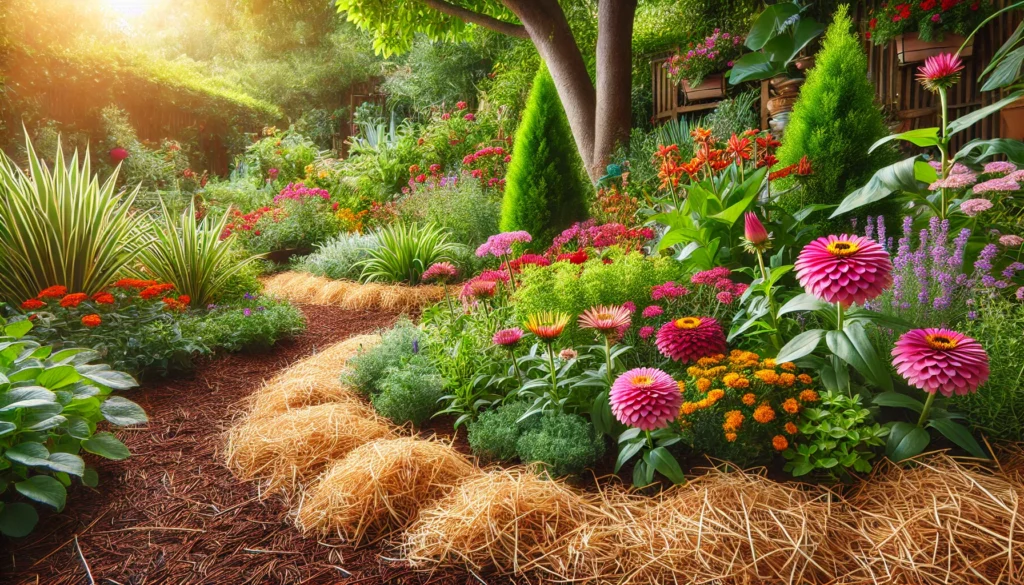
How to Use Pine Straw for Landscaping: Benefits and Tips for Healthy Gardens
Looking for a natural, cost-effective way to enhance your garden’s health and appearance? 
In this guide, we’ll explore how to use pine straw for landscaping, highlighting its benefits and providing practical tips to help you create a thriving, low-maintenance garden. Ready to give your garden the natural boost it needs? Keep reading!
Table of Contents
ToggleWhat is Pine Straw?
Pine straw is the natural mulch made from the needles of pine trees. 
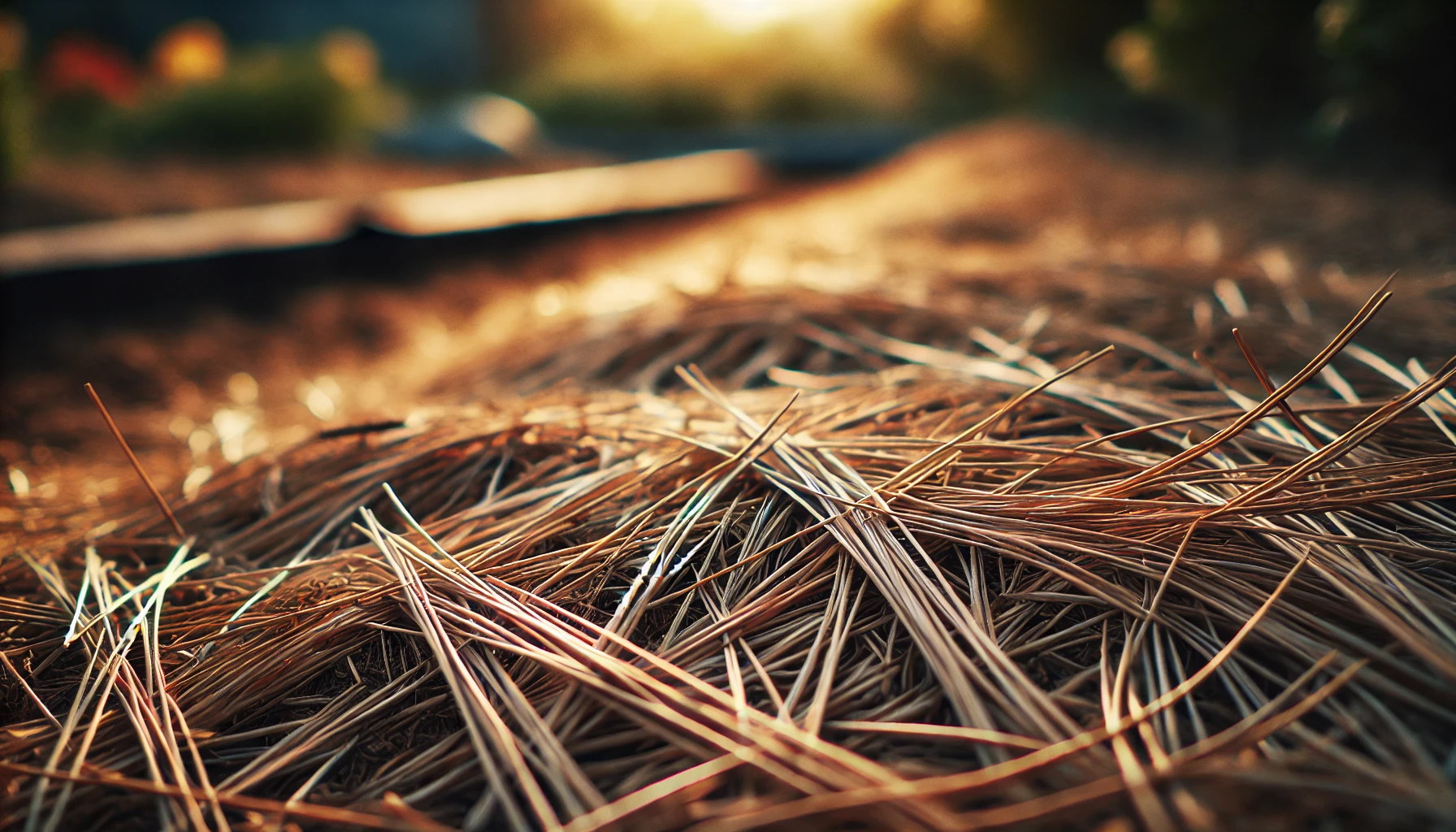
One of the key benefits of pine straw is its ability to retain moisture in the soil. It forms a breathable layer that keeps your garden hydrated, reducing the need for frequent watering. 
Another advantage of pine straw is its natural acidity. It’s perfect for acid-loving plants like azaleas, blueberries, and camellias. 
Whether you’re using it for garden beds, flower borders, or around trees, pine straw is a simple yet effective solution for many landscaping needs.
Benefits of Using Pine Straw for Landscaping 
Pine straw is a fantastic, low-maintenance material that can make your garden thrive. Here’s why it’s an excellent choice for landscaping:
1. Natural Mulch with a Beautiful Look 
Pine straw creates a soft, natural look that complements any garden. Its rich, earthy color enhances flower beds, trees, and shrubbery. Whether you’re going for a rustic or refined style, pine straw adds visual appeal without overwhelming your landscape.
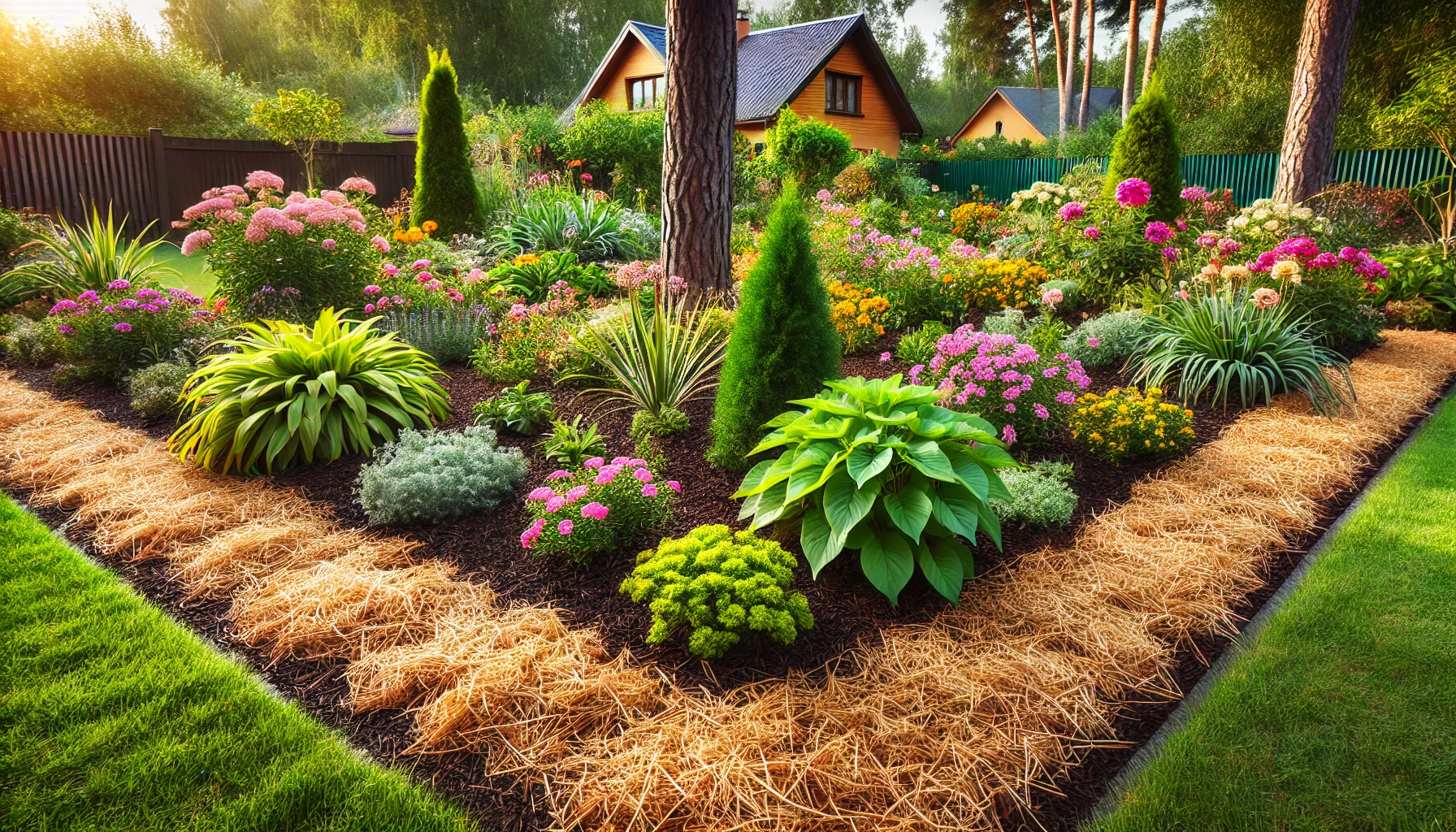
2. Helps Retain Moisture 
One of the key benefits of pine straw is its moisture-retention properties. When spread around plants, it forms a protective layer that helps keep soil moist longer. This is especially beneficial during hot, dry weather, reducing the need for frequent watering and saving you time and effort.
3. Prevents Weeds 
Pine straw acts as a natural barrier to weeds. The thick layer blocks sunlight from reaching weed seeds, preventing them from germinating. This means less weeding for you, making it a great choice for busy gardeners who want to minimize maintenance.
4. Improves Soil Health 
As pine straw decomposes, it releases valuable nutrients into the soil. It also helps improve soil structure, promoting better root growth and overall plant health. Over time, it enriches the soil, creating a healthier environment for your plants.
5. Great for Erosion Control 
If you have a sloped garden or areas prone to erosion, pine straw can help. It forms a thick, stable mat that holds the soil in place, preventing erosion during heavy rains. It’s an eco-friendly way to protect your landscape from weather damage.
6. Long-Lasting and Cost-Effective 
Pine straw is durable and tends to stay in place longer than other mulch options, like wood chips. It decomposes more slowly, meaning you won’t need to replenish it as often. This makes it both a practical and cost-effective option for long-term landscaping.
7. Eco-Friendly 
Using pine straw is a sustainable choice. It’s a byproduct of pine forests, often collected from forests or managed lands. By choosing pine straw, you’re helping reduce waste and support eco-friendly practices.
Incorporating pine straw into your garden is an easy and affordable way to improve the look and health of your landscape. Whether you’re aiming for a neat, low-maintenance garden or looking to reduce watering, pine straw is a versatile and beneficial landscaping material.
How to Use Pine Straw for Landscaping
Pine straw is a natural and eco-friendly option for mulching your garden. Not only does it look beautiful, but it also provides several benefits for your plants and soil. Here’s a simple guide on how to use pine straw effectively in your landscaping:
1. Prepare Your Garden Area 
Before applying pine straw, clear your garden beds of any weeds, leaves, or old mulch. You want a clean surface so the pine straw can settle nicely and do its job. If your garden beds are compacted, lightly rake or loosen the soil for better water absorption.
2. Choose the Right Thickness 
For pine straw to work its magic, you need the right amount. Spread the pine straw in a 2-4 inch layer over the soil. This helps retain moisture, suppress weeds, and regulate soil temperature. Be careful not to pile it too high around the base of plants, as it could lead to rot or hinder air circulation.
3. Place Pine Straw Around Plants 
When applying pine straw around plants, leave a small gap (1-2 inches) between the mulch and the plant stems. This ensures the plants get the airflow they need and prevents the mulch from touching the plant crowns, which could cause rot.
4. Use Pine Straw for Garden Edging 
Pine straw can also work wonders around the edges of garden beds. It creates a neat, natural border and helps prevent soil erosion. This is especially useful in sloped areas where water can wash away soil.
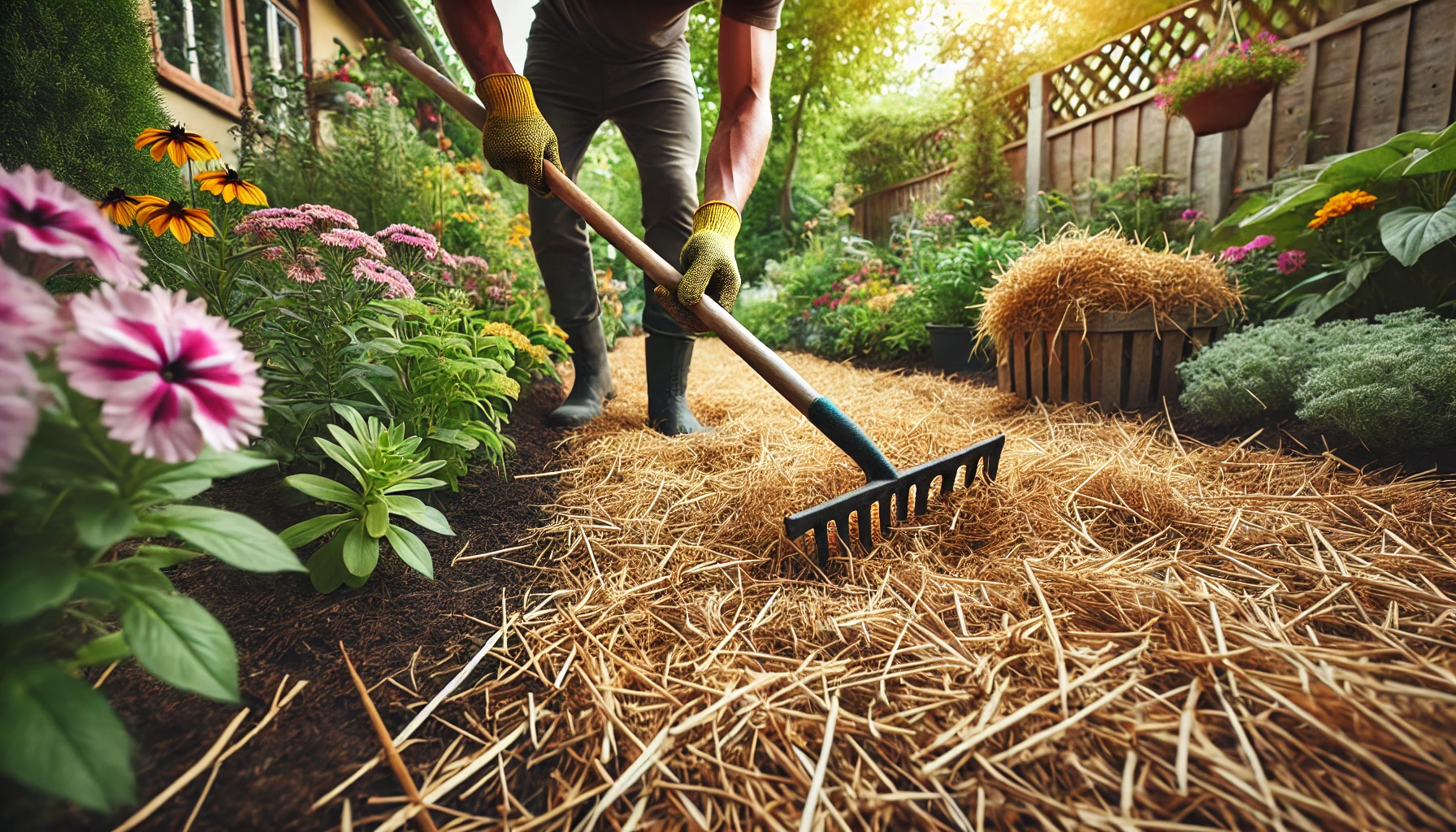
5. Watering After Application 
Once you’ve laid down the pine straw, water the area gently to help settle the mulch in place. This also helps kick-start the moisture retention process. While pine straw holds moisture well, it’s still essential to water your plants regularly, especially during dry spells.
6. Replenish as Needed 
Pine straw breaks down over time, so it’s important to replenish it annually or every two years, depending on weather conditions and how much wear and tear the mulch faces. Adding a fresh layer ensures your garden continues to benefit from the protective and aesthetic qualities of pine straw.
7. Benefits of Pine Straw for Landscaping 
- Weed Control: Pine straw acts as a natural weed barrier, keeping unwanted growth at bay.
- Moisture Retention: It helps keep the soil moist, reducing the need for frequent watering.
- Soil Health: As it decomposes, pine straw adds valuable organic matter to the soil, improving its structure and nutrient content.
- Aesthetic Appeal: Its rich, reddish-brown color complements many garden styles, offering a clean and polished look.
Final Thoughts 
Using pine straw for landscaping is an easy, cost-effective way to enhance the beauty and health of your garden. By following these simple steps, you can enjoy a well-maintained and thriving outdoor space all year long. Happy gardening!
Pine Straw vs. Other Mulches 
When choosing the right mulch for your garden, pine straw stands out as an excellent option. But how does it compare to other types of mulches, like wood chips, bark, and shredded leaves? Let’s break it down and see why pine straw might be the best choice for your landscaping needs.
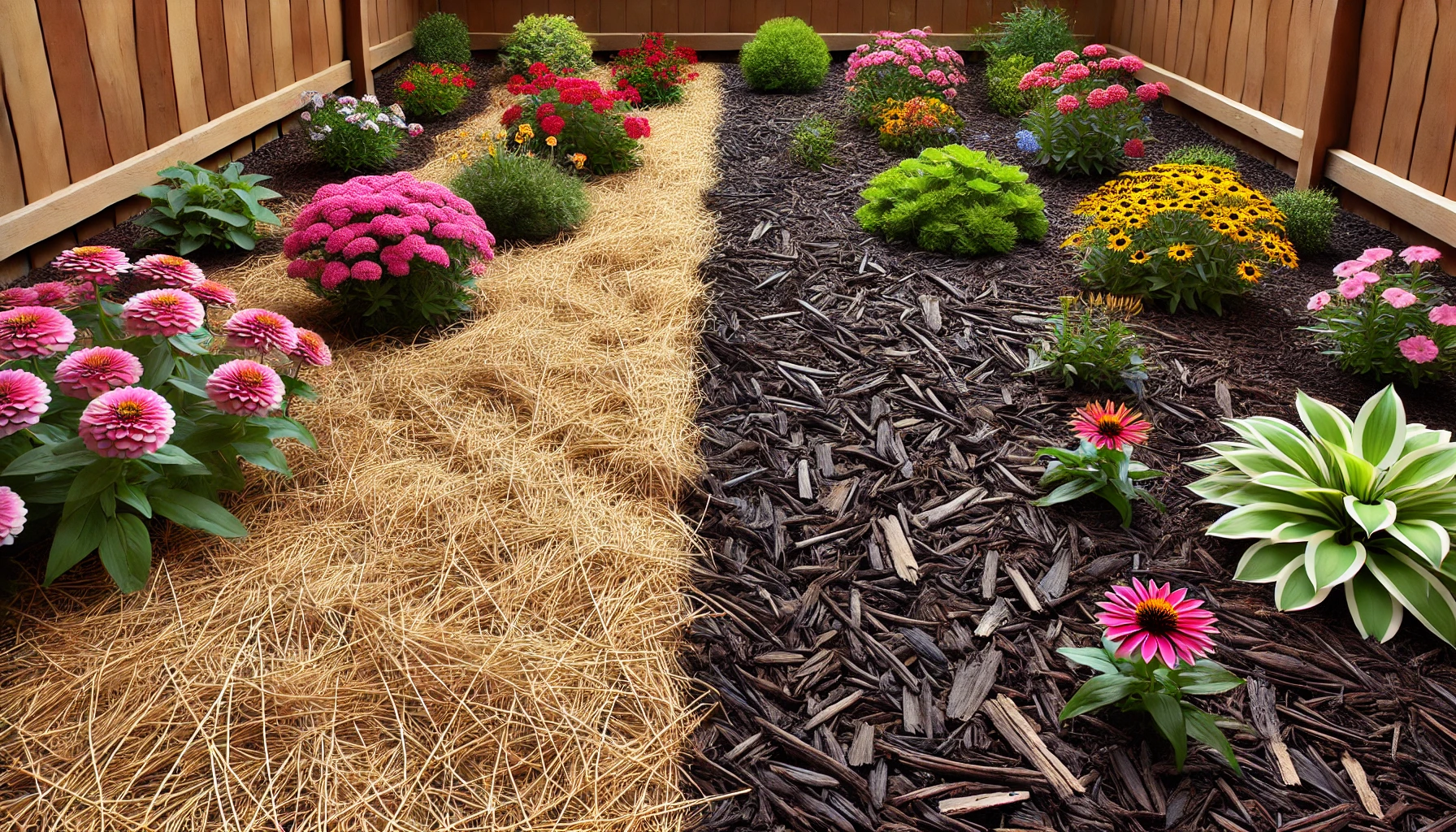
1. Appearance and Aesthetic Appeal 
Pine straw provides a natural, rustic look that enhances the visual appeal of your garden. Its light, airy texture creates a soft, golden color that blends beautifully with plants and flowers. Compared to wood chips, which can sometimes look bulky, or bark mulch, which may be darker and heavier, pine straw gives a lighter, more organic feel to your garden.
2. Weed Control 
One of the main reasons people use mulch is to suppress weeds. Pine straw does an excellent job of blocking sunlight from reaching weed seeds, preventing them from germinating. While other mulches like shredded leaves or grass clippings can break down quickly and allow some weeds to poke through, pine straw forms a dense layer that stays in place and keeps weeds under control for a longer period.
3. Water Retention and Soil Moisture 
Pine straw excels at retaining soil moisture, making it ideal for gardens in hot, dry climates. Its lightweight, airy texture allows water to penetrate easily into the soil, while also preventing evaporation. Other mulches, like bark or wood chips, can sometimes form a thick crust that prevents water from reaching the soil, especially if they become compacted over time.
4. Acidic Benefits for Certain Plants 
Pine straw is slightly acidic, which can be beneficial for acid-loving plants such as azaleas, blueberries, and camellias. While other mulches, like wood chips, are typically neutral or slightly alkaline, pine straw can help lower soil pH, creating a more favorable environment for these plants to thrive.
5. Ease of Use and Maintenance 
Pine straw is easy to spread and lightweight, making it much simpler to work with compared to heavier mulches like hardwood bark. It doesn’t require frequent replenishing, as it decomposes slowly. In contrast, wood chips may need to be topped off every year to maintain an even layer, while straw or shredded leaves break down quickly and require more frequent maintenance.
6. Cost and Availability 
Pine straw is often more affordable than other types of mulches, particularly in areas where pine trees are abundant. This makes it a budget-friendly choice for large gardens or landscaping projects. In comparison, wood chips or bark can be more expensive, especially if you’re purchasing them in bulk or need to have them delivered.
7. Environmental Impact 
Pine straw is a sustainable option, as it’s made from naturally fallen pine needles, which would otherwise decompose on the forest floor. By using pine straw, you’re making use of a renewable resource that would otherwise go to waste. In contrast, some wood-based mulches can contribute to deforestation if they’re not sourced responsibly.
Conclusion
Pine straw offers unique benefits, including a visually appealing look, excellent weed control, and the ability to retain moisture in the soil. It’s especially beneficial for acid-loving plants and can be a more cost-effective and eco-friendly option compared to other mulches. Whether you’re looking to improve your garden’s appearance, keep weeds at bay, or maintain healthy soil, pine straw could be the perfect choice for your landscaping needs!
Tips for Maintaining Pine Straw in Your Garden
Pine straw is an excellent mulching material that offers a range of benefits, from moisture retention to soil temperature regulation. However, to keep it looking fresh and performing its best in your garden, regular maintenance is key. Here are some simple tips to help you maintain pine straw and keep your garden thriving:
1. Refresh Your Mulch Annually 
Pine straw naturally breaks down over time, so it’s important to refresh the mulch each year. Typically, a new layer of pine straw should be added once a year, particularly in the spring. This helps maintain its insulating and moisture-retaining properties, keeping your plants healthy throughout the seasons.
2. Keep It Evenly Distributed 
To ensure your garden beds are consistently protected, spread pine straw evenly across the surface. Aim for a depth of about 2-3 inches. This allows the mulch to do its job without smothering your plants or creating a barrier to water and nutrients. If the mulch starts to clump or thin out in some spots, redistribute it to maintain a consistent layer.
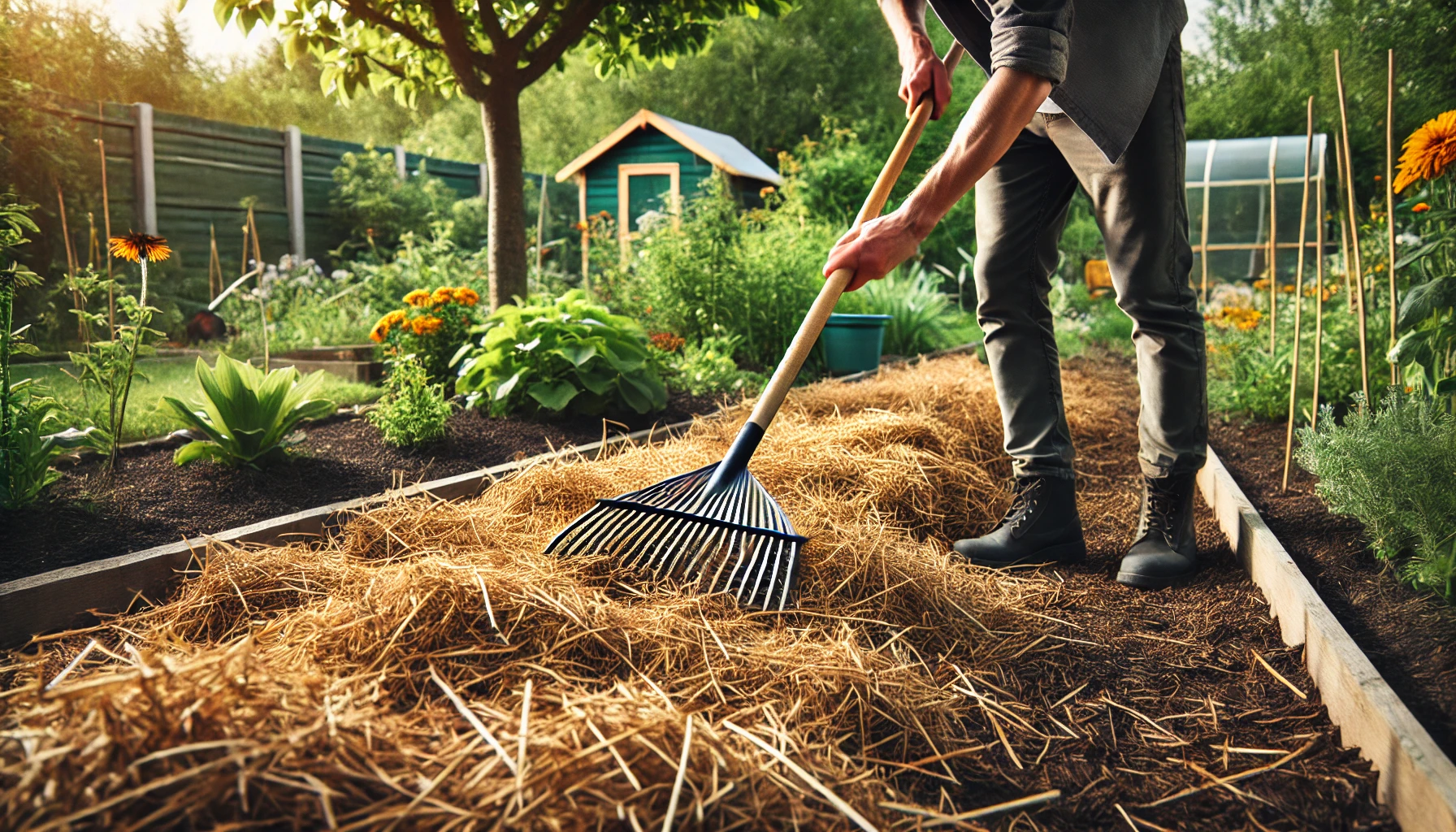
3. Rake Out Debris Regularly 
Over time, leaves, twigs, and other debris can accumulate on top of your pine straw. To keep it looking neat and ensure good air circulation, rake out any debris from the surface every few weeks. This also helps to prevent mold growth, which can sometimes form in damp, densely packed pine straw.
4. Avoid Over-Watering 
Pine straw is effective at retaining moisture, but if you overwater your plants, it can cause the mulch to become soggy and create conditions for mold or fungus growth. Stick to a regular watering schedule, ensuring that you water deeply but not excessively. Be mindful of your garden’s natural rainfall and adjust watering accordingly.
5. Edge Your Beds for Clean Lines 
To keep your garden looking polished, define the edges of your garden beds with edging materials like brick, stone, or plastic garden borders. This helps contain the pine straw and prevents it from spilling onto walkways or lawns. Regularly trim any stray grass or weeds that might try to creep into the mulch.
6. Check for Weeds 
While pine straw does an excellent job of suppressing weeds, some hardy weeds can still push through. Make it a habit to check your garden beds for any unwanted growth. If you spot weeds, pull them out promptly to prevent them from taking over. A layer of landscape fabric under the pine straw can also enhance weed prevention.
7. Watch for Pests 
Pine straw can sometimes attract pests like termites or ants, especially in damp conditions. To avoid this, keep the mulch a few inches away from the bases of plants and trees, as this discourages pests from settling in. If you notice pest activity, take action by using natural pest control methods or a pest repellent suitable for your garden.
By following these simple maintenance tips, your pine straw will continue to be an asset to your garden, helping to conserve moisture, control temperature, and enhance the beauty of your landscape. Happy gardening!
Common Mistakes to Avoid When Using Pine Straw 
Using pine straw as mulch is a fantastic choice for your garden, but like anything in landscaping, there are a few common pitfalls that can hinder its effectiveness. Let’s dive into the mistakes you should avoid to get the most out of your pine straw.
1. Applying Too Much Pine Straw 
One of the most common mistakes is overloading your garden with too much pine straw. While it’s tempting to create a thick blanket, a layer that’s too deep can actually suffocate your plants. Aim for a 2-4 inch layer, which is ideal for weed control and moisture retention. Too much can trap water and create an environment for mold to grow, harming your plants.
2. Not Raking the Straw Properly 
After spreading the pine straw, many people forget to rake it evenly. Uneven layers can lead to areas where water pools or doesn’t reach the roots. Make sure you spread it in a uniform layer to help water flow properly and ensure all your plants are getting the coverage they need.
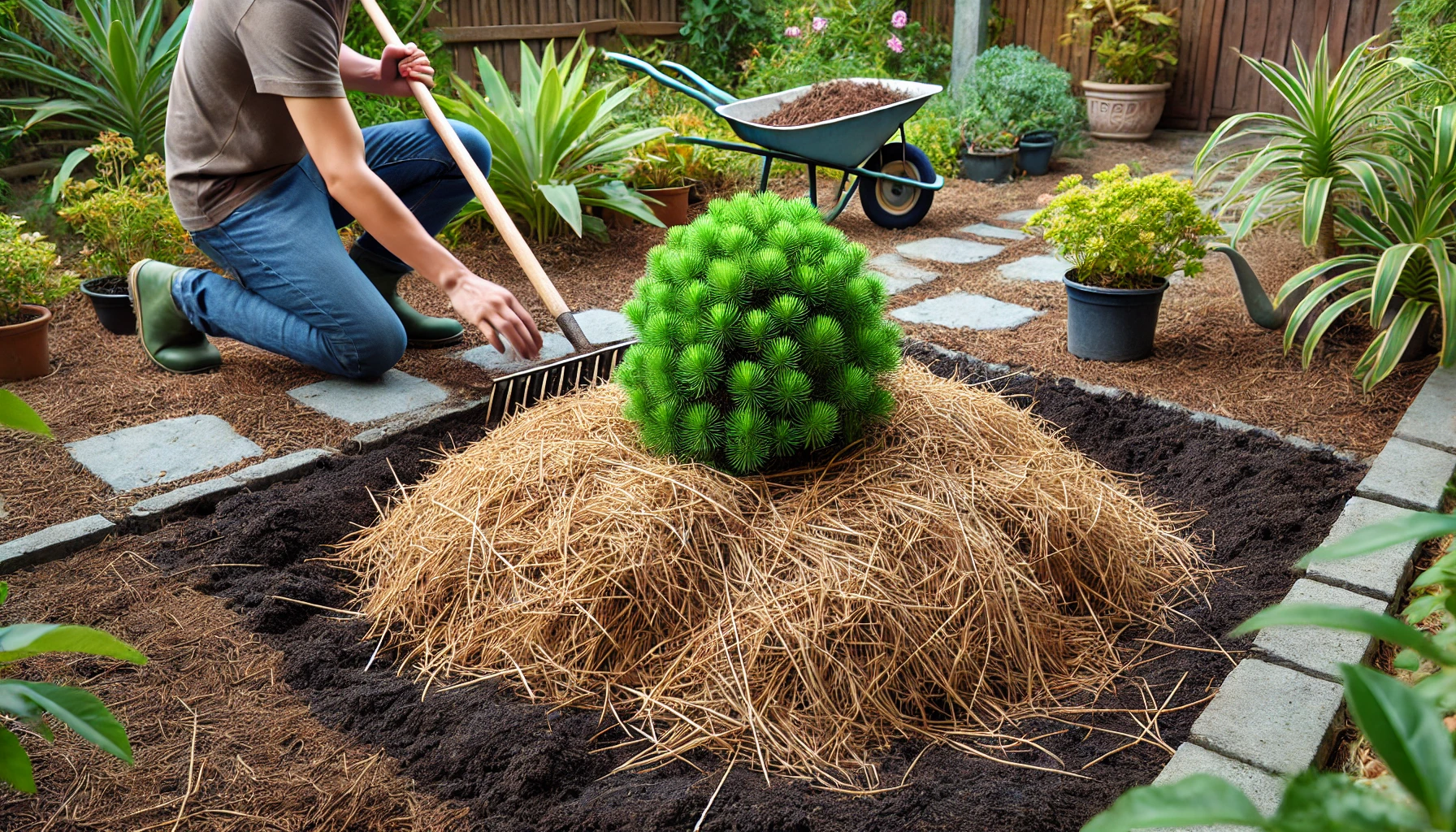
3. Ignoring the Type of Plants You’re Mulching Around 
Pine straw is great for most plants, but it’s not the best choice for every garden. Some plants, like acid-loving plants (e.g., blueberries, azaleas), thrive with the slightly acidic environment pine straw provides. However, other plants might not do as well in this setting. Always consider the specific needs of your plants before deciding to use pine straw.
4. Not Replacing or Refreshing the Mulch 
Over time, pine straw can break down and lose its effectiveness. If you don’t replace or refresh it annually, it can lose its ability to suppress weeds and retain moisture. Make it a point to check your mulch every year and add fresh pine straw when necessary, especially after heavy rains or winter.
5. Using Wet Pine Straw 
If you use freshly harvested pine straw that’s still wet, it can mat together and prevent air and water from reaching your plants. Always allow the straw to dry out a bit before applying it to ensure it remains loose and airy, which helps with proper drainage and plant health.
6. Skipping Weed Control Underneath 
While pine straw helps to reduce weed growth, it won’t eliminate weeds completely, especially if they’re already growing. Be sure to remove any existing weeds before laying down the mulch. Otherwise, the weeds can push through and eventually spoil the appearance and health of your garden.
7. Not Considering Drainage Needs 
Pine straw is excellent for moisture retention, but if your garden has poor drainage, it can create a soggy environment. If you’re using pine straw in areas where water tends to pool, consider adding drainage solutions like gravel or adjusting the layout of your garden beds to ensure proper runoff.
By avoiding these common mistakes, you can maximize the benefits of pine straw and create a beautiful, healthy garden that thrives year-round!
Conclusion
Incorporating pine straw into your landscaping can offer a host of benefits, from enhancing the aesthetic appeal of your garden to improving soil health and reducing maintenance. Its natural properties, such as moisture retention, weed suppression, and temperature regulation, make it a fantastic choice for gardeners looking to maintain a healthy and sustainable garden with minimal effort.
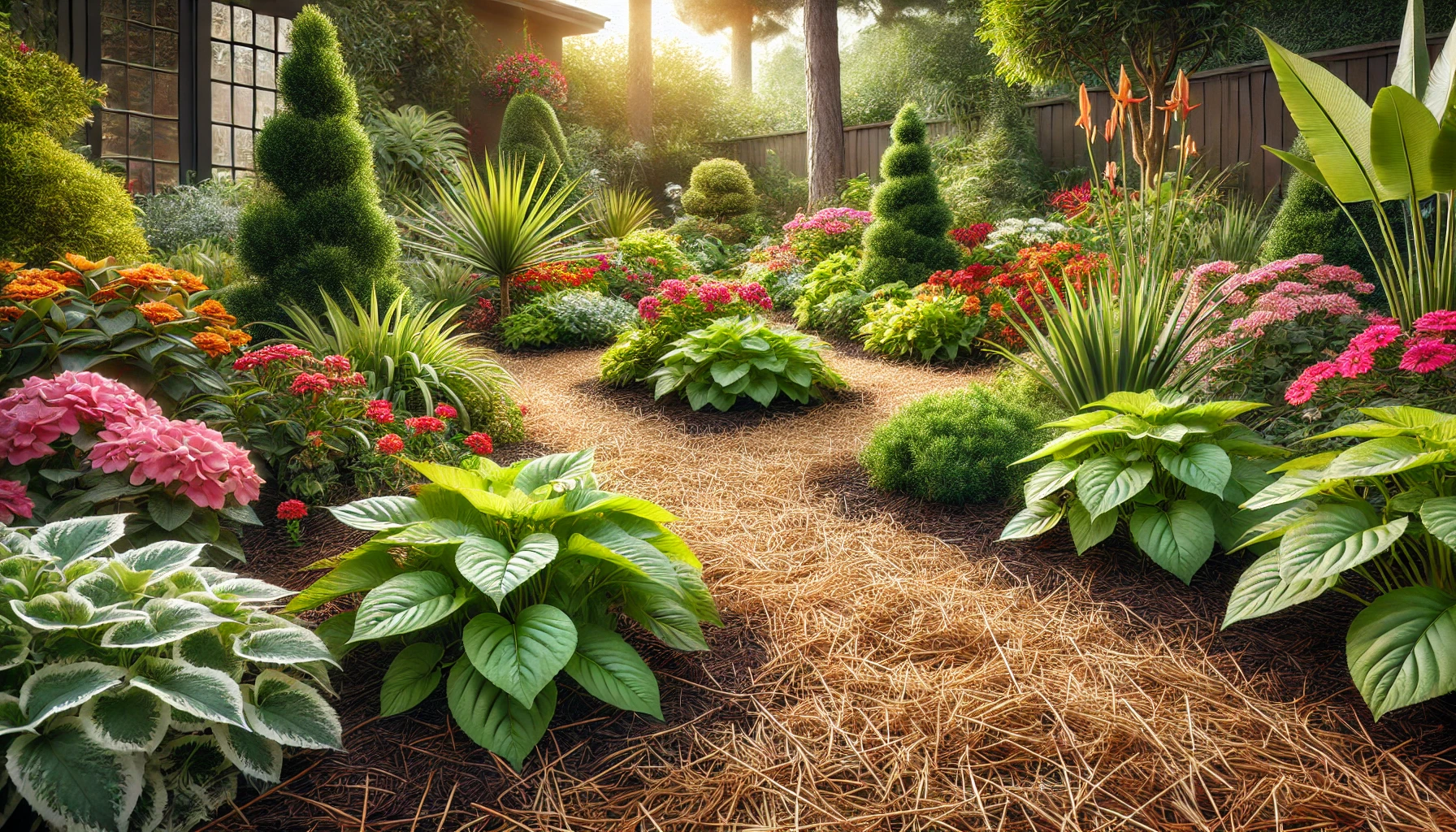
By following the simple tips and techniques outlined in this guide, you’ll be able to apply pine straw effectively, ensuring your plants thrive year-round. Whether you’re using it for flower beds, vegetable gardens, or around trees, pine straw is an affordable, eco-friendly, and versatile solution that works for almost any landscaping need.
Start using pine straw today and watch your garden flourish with healthy, vibrant plants!
Frequently Asked Questions(FAQ)
What are the benefits of using pine straw in landscaping?
Pine straw is an excellent mulch choice for landscaping because it helps retain moisture, suppress weeds, and regulate soil temperature. It also adds an aesthetic, natural look to gardens while improving soil health as it decomposes. It’s eco-friendly, affordable, and easy to apply, making it perfect for various landscaping needs.
How often should I replace pine straw in my garden?
Typically, pine straw should be replaced every 1-2 years, depending on environmental factors like wind, rain, and foot traffic. You can add a thin layer to refresh the mulch if it starts to decompose or thin out, but avoid applying too much at once.
Can pine straw be used in vegetable gardens?
Yes, pine straw can be used in vegetable gardens, but it’s important to avoid piling it directly on plant stems. It helps prevent weed growth and retains moisture in the soil, but make sure to keep it a few inches away from the base of vegetables to prevent rot.
How do I apply pine straw to my garden?
To apply pine straw, start by clearing any weeds or debris from the garden bed. Then, spread a 2-3 inch layer of pine straw evenly around plants, trees, or shrubs, leaving space around the stems to avoid moisture buildup. Water the area after applying to settle the mulch in place.
Does pine straw attract pests?
While pine straw is generally pest-resistant, it can attract insects like termites if used in large quantities around structures. However, this is rare, and using it as mulch around plants usually poses no issues. Keep an eye out for pests and consider using other mulch types if pest problems arise.
Is pine straw better than other types of mulch?
Pine straw is a great choice compared to other mulches like wood chips or bark, as it is lightweight, easy to apply, and provides excellent moisture retention. It also decomposes more slowly than some other organic mulches, requiring less frequent replenishing. However, it can acidify the soil slightly, so it’s best for plants that tolerate acidic conditions.
Can I use pine straw to prevent weeds in my garden?
Yes, pine straw is effective at suppressing weeds by blocking sunlight from reaching weed seeds, helping to prevent them from germinating. For the best results, apply a thick, even layer around plants, trees, and shrubs, especially in areas prone to weed growth.
Will pine straw improve soil quality in my garden?
As pine straw decomposes, it adds organic matter to the soil, improving its structure and fertility. This helps the soil retain moisture, encourages healthy root growth, and supports beneficial microorganisms in the soil, ultimately contributing to better plant health over time.




